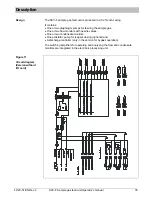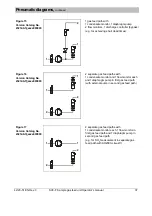
42/23-51 EN Rev. 3
SCC-F Sample gas feed unit Operator’s manual
31
Checking the gas paths for leaks
When do the gas
paths need to be
checked for leaks?
The gas paths should be checked for leaks regularly.
They must be checked after the gas paths inside the sample gas feed unit have
been opened.
The sample gas feed unit must be checked from both sample gas connections
because of the valves in the built-in diaphragm pump.
Check for leaks
Step
Action
1
Block off the sample gas outlet.
2
Apply a positive pressure of 100 mbar to the sample gas inlet.
3
Using a U-pipe manometer, for example (pipe diameter 7 to 8 mm),
check the drop in pressure; this must not exceed 0.1 mbar per minute.
4
Similarly, check for leaks from the other side.
Troubleshooting
Problem Cause
Remedy
Feed unit not
working
Power supply interrupted
Reconnect the power supply.
Fuse blown
Replace fuse (5x20 mm T6.3H250V).
Pump motor blocked
Remove blockage.
Defective pump
Replace pump.
Defective diaphragm
Replace diaphragm (see page 28).
Drops of condensate
in the condensate
monitor or flow
monitor (liquid
alarm)
Condensate being produced
by the gas analysis system
Fluid from the process
penetrating
Sample gas cooler’s
condensate collecting vessel
full
1. Check operability of the upstream condensate
separation device, and rectify cause.
2. Empty, clean and dry the upstream sample gas
pipe and sample gas conditioning units.
3. Empty, clean and dry the condensate monitor.
4. Replace filter diaphragm.
5. Press reset switch on the front panel to
deactivate the condensate lock.
Sample gas flow
insufficient
(flow alarm)
Upstream sample gas pipe
or modules blocked or
sealed off
Remove blockage or open modules.
Downstream modules
blocked or sealed off
Remove blockage or open modules.
Negative pressure on the
gas sampling side
Rectify negative pressure.
Positive pressure in the
waste gas pipe
Rectify positive pressure.












































